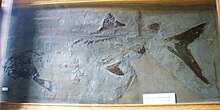Chondrosteidae
Appearance
| Chondrosteidae Temporal range:
| |
|---|---|

| |
| Skeleton of Strongylosteus hindenburgi | |

| |
| Skeletal reconstruction of Chondrosteus | |
| Scientific classification | |
| Domain: | Eukaryota |
| Kingdom: | Animalia |
| Phylum: | Chordata |
| Class: | Actinopterygii |
| Subclass: | Chondrostei |
| Order: | †Chondrosteiformes Aldinger, 1937 |
| Family: | †Chondrosteidae Egerton , 1858
|
| Included genera | |
| |

Staatliches Museum für Naturkunde Stuttgart
Chondrosteidae actinopterygian fishes, known from the Early Jurassic of Europe. They are closely related to modern sturgeons and paddlefish of the order Acipenseriformes, and are either placed as part of that order[3] or the separate order Chondrosteiformes within the Chondrostei.[4] Three genera are known, Chondrosteus, Gyrosteus, and Strongylosteus.[5] Included species were of large size, with body lengths ranging from 2 metres (6.6 ft) up to 7 metres (23 ft). Their skeleton was largely made up of bones (unlike living chondrosteans), but ossification was reduced compared to other ray-fins.[6]
See also
- Prehistoric fish
- List of prehistoric bony fish
References
- ^ L. Grande & W.E. Bemis (1996). "Interrelationships of Acipenseriformes, with comments on "Chondrostei".". In M. L. J. Stiassny; L. R. Parenti & G. D. Johnson (eds.). Interrelationships of Fishes. Academic Press, San Diego. pp. 85–115.
- ^ a b Agassiz, Louis (1833–43). Recherches sur les Poissons Fossiles, Tome I. Imprimerie de Petitpierre, Neuchâtel. pp. 1–188.
- PMID 32002331.
- ISBN 978-1-118-34233-6.
- S2CID 24961905.
- S2CID 86821521.
External links
 Media related to Chondrosteidae at Wikimedia Commons
Media related to Chondrosteidae at Wikimedia Commons
